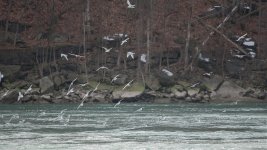That being said, John picked up Purple Sandpiper and Dovekie, so he's unofficially tied the Big Year record! And with a month to go.
Joe
Joe
Can you please explain why he has tied the record. Surely the 2016 record of 836 included Thayers Gull and therefore with the taxonomy change to this being part of the Iceland Gull complex the record is 'only' 835.
Even if it was regarded a 836 at the time, it would need to the adjusted to 835 now ..... or am I missing something?






